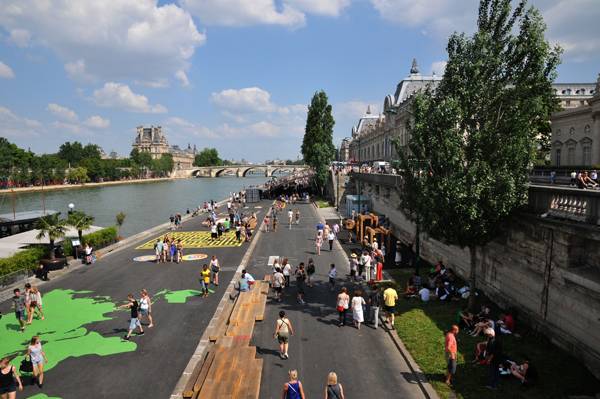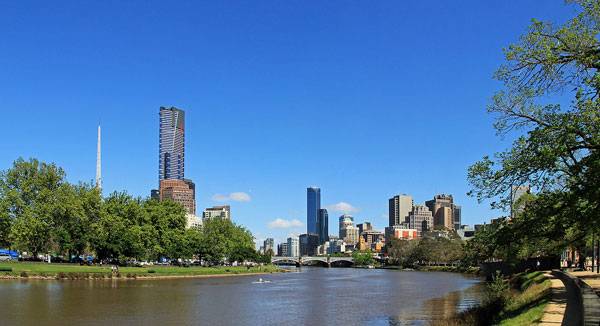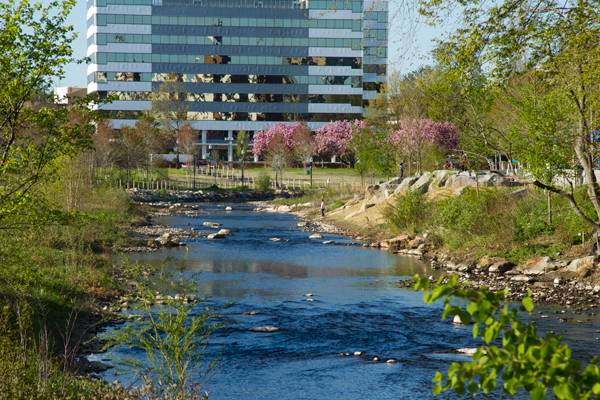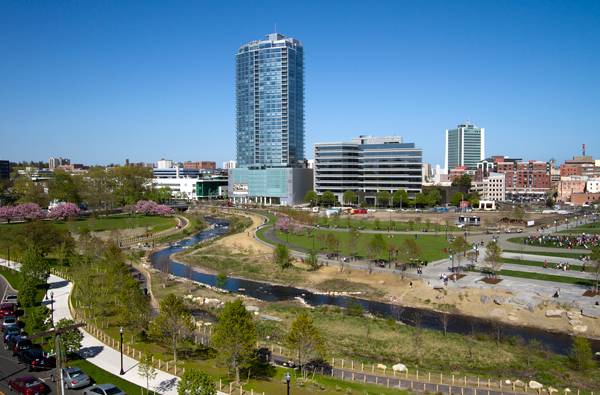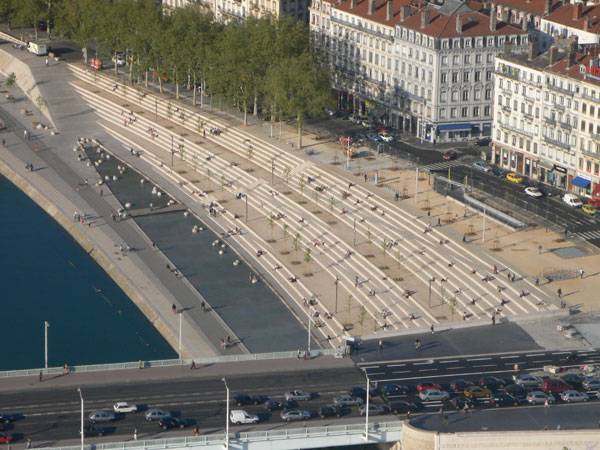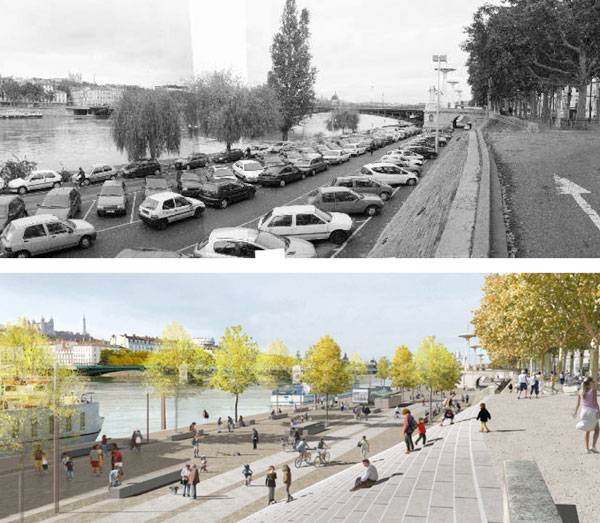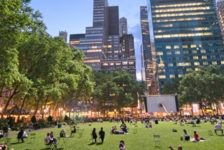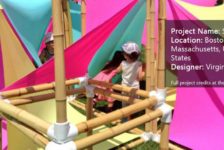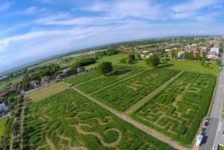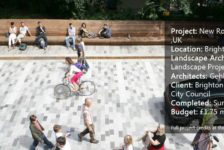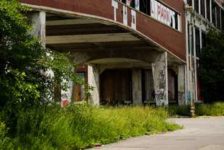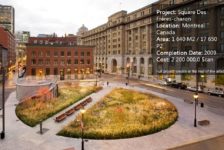A look at some of the world’s most outstanding riverbank projects. When it comes to building sustainable cities, discussion often centers on urban rivers and their surroundings. In many cities around the world, rivers have been channelized, transformed into receptacles for waste disposal, or just forgotten when they are no longer needed for industrial and commercial uses. As a consequence, these rivers have lost their innate ability to aid in flood control, seen their aquatic life destroyed, and gone unnoticed due to construction of barriers that blocked their access and hid them from residents’ eyes. But in other cities, once dead spaces along rivers are being brought back to life and transformed into recreational areas, meeting the demand for outdoor spaces from quickly growing populations. As in music, where the notes and the pauses have equal importance, an increase in constructed areas must harmonize with green space to guarantee liveable cities for the future.
Inspiring Riverbank Projects
Riverbanks can set the new pace for this composition. The following list offers some of the most inspiring river transformations that have improved the relationship between city residents and nature, inviting people to look at rivers not as obstacles, but as vital and connective urban components. 10. Berges de Seine, Paris, France, by Franklin Azzi Architecture The combination of historic bridges and monuments along the Seine River has made this place one of the top tourist attractions in the world. Some may think that the designation of the famous riverbanks as a UNESCO World Heritage Site means that the place cannot be changed. But the initiative of the local authority, known as Berges de Seine, is showing that historic riverbanks can be modernized to adapt to the current needs of a city.
An open-air park along the Seine is filled with benches, bars, gardens, and playgrounds (some making use of recycled materials such as ship containers), making the area along the Seine more attractive for tourists and recovering its importance as a meeting point for city residents. The riverbank regeneration project is also seriously engaged in motivating physical activities, such as group walks; providing more adequate seating areas to watch performances; and reorganizing the public space so that it can be better shared by pedestrians, cyclists, and drivers. 9. Melbourne Southbank Promenade, Australia, by Denton Corker Marshall Surrounded by a variety of arts and cultural buildings and featuring cafes, shops, and restaurants, the Southbank Promenade stretches along the south side of the Yarra River as one of the most important cultural and social hubs in Australia. The design was completed in the early 1990s when the former dock site was the subject of an urban renewal. The promenade paved the way for important developments that transformed the area into a successful business center. It is still fundamental to attracting investments and enticing people with a variety of leisure options and splendid views of the river and the city. 8. Mill River Park, City of Stamford, Connecticut, USA, designed by The Olin Studio in collaboration with the Mill River Collaborative Although there are several stages to be completed in the upcoming years, some important parts of the total 28-acre area are already finished, and they are significantly improving the residents’ quality of life by enabling people to experience nature without leaving the urban environment. The project encompasses the creation of world-class recreational facilities, attractive green areas, and walkways. But its main feature is the restoration of the urban section of the Mill River and its banks. By applying approaches of sustainable design and bio-engineering techniques, the design and technical teams worked together to remove concrete walls and de-pollute the water to allow the river to flow freely, storm water to be absorbed, and wildlife to return to the area. The riverbanks have become the focal point of this new space that has transformed a decaying downtown area into a healthy central park. Read more in our review of the Mill River Park. 7. Louise McKinney Riverfront Park, Edmonton, Alberta, Canada, designed by Dialog As Edmonton is one of the fastest-growing cities in Canada, urban revitalization projects such as the Louise McKinney Riverfront Park, which created a 15-hectare green space in an area formerly occupied by a landfill, are fundamental to keep the balance between increasing constructions and nature. The preference for a verdant open space over more complex solutions has provided an unobstructed river view for developments adjacent to downtown and a lawn for recreation and special events. The park is the gateway to trails, motivating people to explore the outdoors beyond the city boundaries and allowing newcomers and longtime citizens to celebrate the riverfront during special events. 6. Kallang River Bishan Park, Singapore, designed by Atelier Dreiseitl This project is part of Singapore’s program of water management, which aims not only to guarantee an efficient drainage and supply system, but also to transform areas located along the water into recreational and social spaces. Completed in 2012, it occupies a total area of 62 hectares redesigned around a restored sinuous river to offer green spaces, restaurants, playgrounds, and a look-out built using recycled concrete from an old channel. WATCH: Have you met the Friends of Kallang River @ Bishan Park? Because the design is based on a floodplain concept, during rainy season the park works as a channel and, when the water level is low, the soft riverbanks can be used for recreation, allowing people to get close to the water. Another important achievement for the urban environment was the increase of biodiversity brought by the transformation of the concrete channel into a re-naturalized river that now flows freely, surrounded by vibrant spaces. WATCH: Kallang River at Bishan Park 5. The Red Ribbon Park, Tanghe River, Qinhuangdao City, Hebei Province, China, by Turenscape The 500-meter-long red ribbon was the surprising solution found by the designers to preserve natural habitats and create recreational and educational areas along the river. Made of fiber steel, the ribbon stretches along the riverbank, working as a winding seating component and integrating the walk pathways to the diverse spaces in the park. The contrast of the “red ribbon” with the green areas during the day becomes even more interesting at night, due to red glowing light installed inside.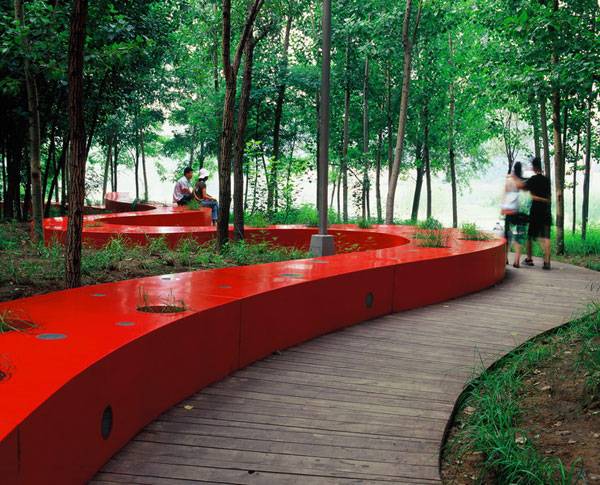
The Red Ribbon as romantic meeting place at Qinhuangdao City, Hebei Province, China. Credit: Turenscape
- How Industrial Landscapes Can Become Beautiful Sites
- Extraordinary Development Re-connects City With The River Bank
- RheinRing Bridge is a Work of Art!
Since its completion in 2008, the 20-hectare green area that replaced the formerly inaccessible riverbanks is being massively used by the growing urban population without compromising the goals of preservation of the environment. The ribbon has been working as a key component of this success because it is the “spine” that provides structure to the space and makes reference to ancestral Chinese myths of energy flow, allowing people to identify with the environment through their cultural heritage.
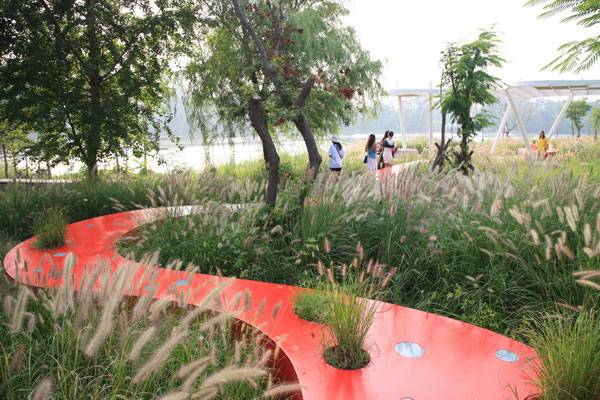
The red ribbon runs across open the field of a former garbage dump at Qinhuangdao City, Hebei Province, China. Credit: Turenscape

This industrial site represents 50 years of Socialist industrial history and was a witness to China’s Cultural Revolution. Credit: Turenscape
- Landscape Architecture Now! by Philip Jodidio
- Landscape Graphics by Grant Reid
Article by Tania Gianone Return to Homepage
Published in Blog


